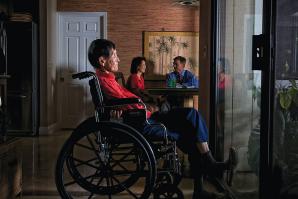Nearly 800,000 Americans have a new or recurrent stroke each year, making it the leading cause of disability in the U.S. What’s more, health problems are a principle driver for mortgage foreclosures and personal bankruptcies, leading to billions in financial impact.
Of the 800,000 annual stroke victims, more than 80 percent survive. Most face an uphill battle of recovery and rehabilitation, and many are unable to drive, much less return to work. For small-business owners, that can lead to lost jobs and businesses closing. For families, it can mean a sudden and huge financial burden. Even for the insured, costs of medical care, therapy and medications can be overwhelming, and that’s before confronting the effects on one’s ability to work while caring for a survivor.
According to 2005 data from the Life Insurance Marketing Research Association, a global research organization for the financial services industry, disability causes nearly 50 percent of all mortgage foreclosures nationwide and is the main factor in more than 350,000 personal bankruptcies annually. LIMRA compiled the data before the nation’s economic recession — a time when most U.S. households were comfortably relying on two incomes. Despite these realities, LIMRA findings show only 26 percent in the private sector work force — and only 13 percent of small business owners — have long-term disability insurance.
“My main advice to anyone is to provide for long-term care,” says Mike Ikemoto, who had a stroke at the age of 38 and had to leave his job. “Have something in place that will cover you until you’re 65 and Medicare takes over.”
Ikemoto’s story highlights the misconception that having a stroke is an older person’s disease. In fact, it can strike at any age; tragically, not even children are immune. Regardless of age or the severity of a stroke, however, there are common denominators related to medical care, rehabilitation and long-term care that apply to every case. The average hospital stay can range from four or five days to a few weeks if multiple surgeries are required. Inpatient rehabilitation therapy at a specialized facility can take another two to three weeks, and when the survivor finally comes home, he or she might need to be monitored 24-7 for several more weeks, for their own safety.
“It’s very easy for survivors to get hurt as they’re recovering,” says Dr. Karanjit Basrai, a director with the Sutter Rehabilitation Institute in Roseville. “Things we take for granted, like getting out of bed, walking down the hall and brushing our teeth are all lost. Survivors need help with even the simplest activities, and it’s not safe to leave them home alone.”
That can have a big affect on a family’s finances, since most insurance doesn’t cover 24-hour caregiver services, says Liz Falltrick, a case manager with the Sutter Rehabilitation Institute. Few families can afford that kind of cost, meaning it may be necessary for a spouse or other relative to take time off work to provide full-time care at home.
All of this speaks to a suite of preparations that should be put in place to ensure that if a stroke strikes, its health and financial impacts are minimized. Some long-term disability policies specify that, if the survivor is able to return to “any occupation,” then he or she is not considered disabled, while others provide coverage as long as an individual is unable to return to his or her “own occupation.”
Next, have a plan in place so family members or loved ones can make decisions in the event you are incapacitated.
“Make sure there’s someone who has power of attorney to act on your behalf,” says Rosey Ramsey, a registered nurse who had a stroke at age 52. “That’s not just for medical decisions. You need someone who’s going to be able to handle your finances, at least for the short term.”
Any good financial adviser will tell you to have enough savings to cover three to six months of expenses if the household income suddenly drops to nothing. According to data from Kelton Research, however, nearly four in 10 Americans say if they became disabled and could not work, finances would become difficult in just two weeks.
That scenario makes it all but impossible for a working spouse to provide the constant care, supervision, transportation and other needs vital to aiding a survivor’s recovery. In a recent survey of adult heart disease and stroke patients by the American Heart Association, 46 percent of patients who had difficulty paying medical expenses said they delayed getting needed health care and 43 percent had not filled a prescription.
What can make that situation all the more tragic is the importance of medical treatment in the first six to 12 months after a stroke occurs because that is essentially the only window for maximizing recovery.
“There’s something called neuroplasticity. It’s the brain’s ability to heal itself,” says Dr. Albert Hwang, director of the Acute Rehabilitation Unit at Mercy General Hospital in Sacramento. “The brain has some ability to grow back new cells, and that process takes place in the first year. It’s important to act on therapy during that time to retrain the cells and help the brain develop new pathways for doing everything from speaking to walking.”
If possible, inpatient therapy should begin within days of a stroke. The typical price tag hovers at about $50,000, followed by aggressive outpatient therapy for the next several weeks, sometimes months. For working spouses or other caregivers, that can require substantial time away from work, further straining finances. Ultimately, it could lead the patient to be able to return to some kind of work, or have less need for constant care and medical attention.
According to the American Heart Association, the most common causes of stroke include physical inactivity, high cholesterol, obesity, diabetes, high blood pressure, stress, smoking and illegal drug use.
“We often have patients leave our facility in wheelchairs after two weeks of inpatient therapy, and walk back in the door on their own power after a few months of regular and aggressive outpatient therapy,” says David Ferneau, Mercy General’s Director of Rehabilitation Services. “We’ve seen it proven over and over again — patients who have a supportive and reliable support network of friends and family, and can get the therapy they need, have much better recoveries.”
Finally, education is key. Although a stroke is generally defined as interruption of blood flow to the brain, there are different kinds of strokes. An ischemic stroke is caused by a clot in one of the brain’s blood vessels, while subarachnoid or intracerebral hemorrhage, two kinds of “bleeding in the brain,” are the result of a burst blood vessel.
Knowing how to recognize the symptoms of stroke and taking immediate action can drastically affect the outcome. As few as three hours can make a huge difference in the patient’s recovery time.
“We like to say that ‘time is brain,’” says Dr. Karsten Dengel, a neurologist with Mercy Medical Group in Carmichael. “The longer you go without taking steps to return blood flow, and therefore oxygen, to the brain, the more chance there is of permanent damage.”
If the patient can get care within three hours of an ischemic stroke, doctors can give a drug called TPA, which rapidly dissolves the clot and restores blood flow quickly. After more than three hours, however, use of TPA comes with greater risk of injury to the patient and doctors won’t use it.
Since strokes can come without any feelings of pain, victims of milder events may not even realize a stroke has occurred, to the detriment of their long-term prognosis. More massive events can be recognized by severe weakness or complete immobility of half the body. In between, the most common symptoms include the sudden onset of numbness, difficult coordination, trouble with balance, slurred or nonsensical speech or inability to understand others’ speech, trouble swallowing or partial loss of vision. Doctors advise against ignoring any of these symptoms, adding that if they are present it’s critical to get to a hospital right away.
Last, knowing what the risk factors are for a stroke and taking steps to minimize those risks wherever possible can help prevent it from occurring in the first place. Age and genetics play a role, but the bulk of the risk factors involve lifestyle choices. According to the American Heart Association, the most common include physical inactivity, high cholesterol, obesity, diabetes, high blood pressure, stress, smoking and illegal drug use. Of course, having one stroke also puts a patient at greater risk for another, meaning different lifestyle choices are the only option for survivors.
“There is usually some contributing factor to a first stroke event,” Basrai says. “Whatever that factor is needs to be addressed to prevent another stroke.”
Even so, there are still those cases that are difficult to assign a specific cause. Ikemoto’s stroke occurred while he was out on his usual five-mile run after dinner. His wife found him on the ground not far from their home, terrified and unable to speak or move. Six years of physical, occupational and speech therapy later, he says he’s about 90 percent able-bodied on his right side. The other 10 percent is “still missing,” and he cannot work.
“It was emotionally very hard to realize I couldn’t go back to work. I loved my job,” he says. “Even though my employer provided a good long-term disability benefit, my wife had to switch from working part time to full time just so we’d have benefits. On the positive side, I get to be a full-time dad to my son, who’s 4 now.”
Recommended For You

Personal Guarantee
Long-term insurance today, long-term assurance tomorrow
When 52-year-old Rosey Ramsey had a stroke in August 2002 she was one of the lucky ones.

Take Care
Proper planning makes all the difference for caregivers
When his mother fell for the second time, Steve Smith was ready to put the plan in motion.



